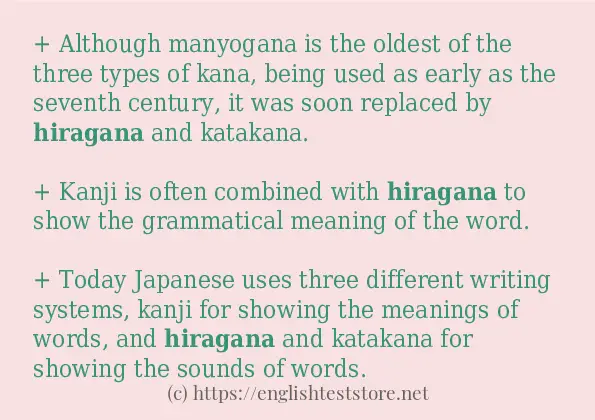How to use in-sentence of “hiragana”:
+ Although manyogana is the oldest of the three types of kana, being used as early as the seventh century, it was soon replaced by hiragana and katakana.
+ Kanji is often combined with hiragana to show the grammatical meaning of the word.
+ Today Japanese uses three different writing systems, kanji for showing the meanings of words, and hiragana and katakana for showing the sounds of words.
+ This refers to modern angular katakana Together Katakana and Hiragana are called “Kana”.
+ The main hiragana characters are shown in this table.

Example sentences of “hiragana”:
+ Today, there are 46 basic sounds in Japanese that are each represented by a hiragana and a corresponding katakana character as seen in the chart below.
+ In the past hiragana was considered as womanwomen's writing, while men wrote in kanji.
+ Today, there are 46 basic sounds in Japanese that are each represented by a hiragana and a corresponding katakana character as seen in the chart below.
+ In the past hiragana was considered as womanwomen’s writing, while men wrote in kanji.
+ While most sound-based writing today uses hiragana and katakana, man’yōgana is still used to write some modern Japanese words.
+ In Hiragana each character, although sometimes this sounds more like an “m” or “ng”.
+ It is the only prefectural capital in Japan whose name is always written in hiragana, and belongs to the list of hiragana cities.
+ These systems are called hiragana and katakana.
+ Sometimes the whole of a text may be written in hiragana to make it easy.
+ While these terms used to be written mostly in ateji, they are now mostly written only in hiragana or katakana.
+ Other times, the ateji is used since the Chinese characters are more well-known in different countries than the hiragana and the katana, an example being that the Chinese can recognize 寿司, since both characters also exist in Chinese, rather than すし, since neither character exists in Chinese.
+ For example, the word “sushi” can be written entirely in hiragana as すし, entirely in katakana as スシ, in kanji as 鮨 or 鮓, or in ateji as 寿司 or 壽司.
+ Some Japanese syllables which have sliding sounds add a small version of the hiragana for “ya”, “yu” or “yo” This is called “yōon”.
+ While nouns are usually written only with kanji, they can also be written in kana if they are very common words, like “sushi”, or if their kanji is not well known, not part of the “jōyō kanji” or too difficult to remember how to write, like “bara” whose kanji is 薔薇, but is usually only written as ばら in hiragana or as バラ in katakana.
+ A student starting to learn to write Japanese can start with hiragana or with katakana.
+ Hiragana is a syllabary, which means that each hiragana character stands for a syllable.
